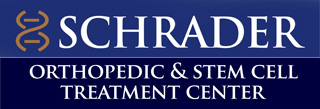Knee-d a little relief? About Unicompartmental Knee Surgery
People in Tennessee, specifically those who suffer with osteoarthritis (degenerative or commonly known as wear-and-tear arthritis) have an edge on the rest of the country. Actually, Dr. Larry Schrader, a local orthopedic surgeon, has the "cutting" edge (no pun intended), with the Unicondylar Program, unicompartmental knee surgery or partial knee replacement.
Dr. Schrader, who earned his medical degree and did his residency at the University of California in San Francisco, practiced medicine in Santa Cruz, California until 1997, when he moved to Tennessee. Dr. Schrader and his wife Kathy live in Memphis and have five sons.
An All-American track and field athlete at the University of California at Irvine, Dr. Schrader is like many other athletes who are going into medicine. "It is common for many to specialize in orthopedics."
After becoming an orthopedic surgeon, he became interested in the partial knee replacement technique and learned it from Dr. Donald Serot in St. Louis, Mo., as well as the doctor who developed it, Dr. John Repicci, in Buffalo, N.Y. "Dr. Repicci was a dentist before an orthopedic surgeon," Dr. Schrader said. "He developed this procedure over 25 years."
Dr. Repicci explains osteoarthritis by comparing it to a tire. "The knee has a joint surface or 'tread,' much like a tire has tread." So, therefore, he goes on to say, "Osteoarthritis may be considered ‘tread disease,' a progressive degenerative process that results in wearing out of the joint surface or 'tread.' The joint surface eventually erodes away, exposing the underlying bone. This loss of tread, or joint surface, may be compared to a bald tire. The exposed bone is painful with weight bearing.
"A normal knee is a joint made up of three separate areas that act like the tires of a car, enduring the rough road of walking and other daily activities. Knee osteoarthritis most commonly develops in one 'tire' while sparing the other."
In total knee replacement, up to an eight-inch incision is made and the kneecap is dislocated, exposing the surfaces of the knee. Up to one-half-inch of bone is removed from the femur and the tibia to accommodate the knee implant. After surgery, most patients stay in the hospital several days and follow up with extensive physical therapy. The long-term result is usually excellent, but it can take many months for the patient to fully regain the function of their new knee joint.
The unicompartmental knee surgery (or partial knee surgery), on the other hand, is good for patients who exhibit osteoarthritis in one compartment and don't need a total joint replacement to relieve pain and restore function of the knee. The Repicci II technique is designed to address this need. The device used in this technique is much smaller than a total knee implant and leaves the healthy tissue intact. Over the last 25 years of development, implant design, instrumentation and surgical technique have improved, making unicompartmental knee replacement a successful treatment.
Using the partial knee technique, a smaller incision is made, there is less blood loss and the kneecap is not disturbed during the procedure. Benefits of the less invasive procedure include less postoperative discomfort, a shorter hospital stay, less physical therapy and more rapid healing. Most patients walk on their resurfaced knee the same day as surgery, and within two weeks most patients are driving a car and resuming most normal daily activities. Also because less bone is removed, future total knee replacement procedures can more easily be performed, if necessary.
"Not many people know about this procedure," Dr. Schrader said, "but 95% of the surgeries done are still working properly at 10 years." Statistics indicate that 98% of people have wear only on the inside of the knee, making this procedure a better option for many patients.
Dr. Schrader performs this technique at Delta Medical Center and St. Francis Bartlett in Memphis, Tennessee. "When people are educated about this treatment, it will become the "norm" rather than the exception and will be more in demand. I don't treat X-rays, I treat patients based on their pain. We go through simple treatments first — medication, shots. Of course, every course of treatment is individualized. I give all my patients choices," Dr. Schrader said. "You tailor the treatment to fit the patient's needs."
Dr. Schrader's confidence in the technique extends to the companies who prepare the parts for these procedures. "These companies are so helpful. They develop the individualized parts for each patient at no charge," he said. "They use computer generated models of the patient's joint When I see this, the engineers and I can decide what to do.
With the unicompartmental knee implant, you actually end up with a knee that performs much more normally, without the long recuperation and extended therapy. Our routine is to have our patients up and walking in two hours after surgery. This is usually done as on an outpatient basis. He said, “If it is right for the patient, I recommend it.” Recently, Dr. Schrader was among the first group of surgeons authorized to use a mobile bearing partial knee called the Oxford prosthesis. Of course Dr. Schrader continues to perform total knee replacements and revisions, if they are deemed necessary.
Less recuperation, less blood loss, less therapy, less time in the hospital, less cost…maybe this time less is better. You deserve a choice in surgeries that address your needs.
Contact Us

Schrader Orthopedics &
Stem Cell Treatment Center
927 Cordova Station Ave
Cordova, TN 38018
Ph: 901-465-4300
New! Stem Cell Therapy
Dr. Lawrence Schrader is a participating team member of the California Stem Cell Treatment Center and Cell Surgery Network.
California Stem Cell Treatment Center
and Cell Surgery Network







